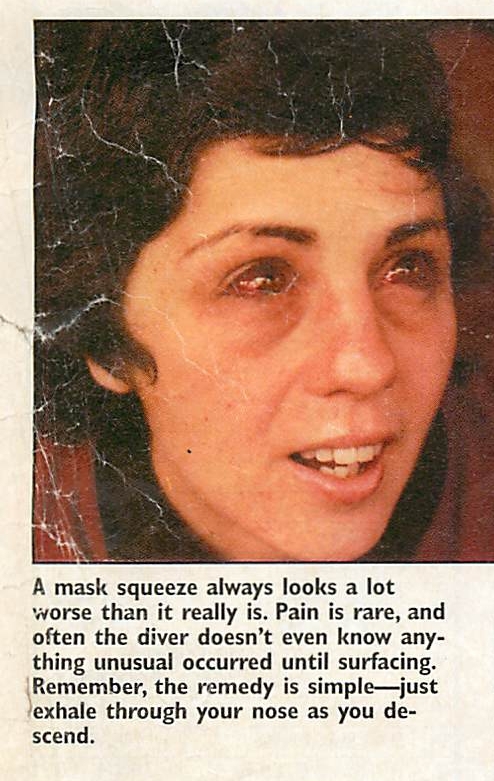
BAROTRAUMA CAUSED BY EXTERNAL AIR SPACES
According to Boyle's law, flexible gas spaces will compress as pressure is applied to them externally. Put a face mask on and go down in the water. The pressure of the water will try to make the face mask smaller. Because it is rather rigid other things will happen first. The pressure inside the body is also greater than the pressure inside the mask. So, the face is "pushed" into the mask. Possible results: The eyes bulge, the nose bleeds, blood vessels break under the skin and in the whites of the eyes, the vision narrows, and there may be swelling. Depending on the difference in the pressure the barotrauma to the face will vary. The diver may not notice the squeeze or damage because there is not much pain connected with it. To avoid face mask squeeze gently exhale through the nose as you descend. This will keep the pressure differential to a minimum so no facial damage can occur. When the squeeze happens some divers have left the water looking like they were involved in a serious domestic encounter. Usually the appearance of a face mask squeeze barotrauma is worse than it really is. It usually does not require treatment and will go away in about a week.

If you were to wear goggles in scuba diving serious barotrauma to the eyes may result. There is no provision for adding air to the inside of the goggles as descent is made because the nose is not in them. Goodbye eyeballs!
As the divers comes up the expanding air in the mask will simply bubble out without notice. There is no concern for mask barotrauma on ascent.
Dry suits contain air. That air will compress as the diver descends. The suit will feel like a total body blood pressure cuff as the outside pressure increases. The skin may be pushed into the natural folds in the suit. Blood vessels may burst in the skin causing lines of blood blisters and bruises. As with any other air space that is connected to the body, air must be added to the dry suit when going down to prevent the squeeze. And, most importantly, the air must be removed as the diver ascends to avoid an out-of-control ascent because of the expanding air in the suit. Dry suits require an extra measure of training that is way beyond the training needed for a wet suit!